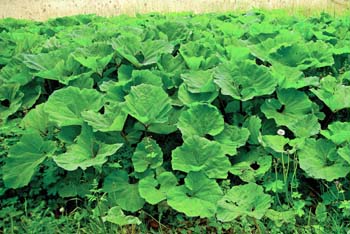New Account | Seed Mix |
Gift Certificates |AAS Winners |
Gardening Products
SEEDS: Unusual | Annuals | Perennials | Vegetables | Herbs | Trees
Great Burdock Seeds
The large leaves grow from a carrot-like root that can penetrate over two feet into the ground.
It is this Burdock root that is most often used in herbal medicine. After a year of growth, Burdock puts forth a branched stalk with smaller leaves and, in the late summer, purple-pink flowers.
In autumn, these flowers are replaced by round brown burrs that persist into the winter. The herb seeds contained in these burrs are also used medicinally.
Useful gardening information
Temperature: Sow at Max 41F, germination irregular often several monthsAverage Germ Time: 30 - 90 days
Light Required: Yes
Depth: 1/4 inch
Sowing Rate: 2 - 3 seeds per plant
Moisture: Keep seeds moist until germination
Plant Spacing: 36 - 48 inches

SF097 Great Burdock ( Arctium Lappa )
Greater Burdock is a biennial plant, rather tall, reaching as much as 8 feet tall in good soil.
Although burdock grows wild and thrives throughout the United States, it is not native. It was introduced by the early settlers and was quickly adopted by the American Indians for their own gardens. These coarse perennial plants are weeds in many temperate areas. The tops die down in the winter. New sprouts arising from roots in spring are peeled and eaten raw or cooked. The dried roots from the first year's growth and the seed are used medicinally. One of 4 ingredients in the Essiac® anti-cancer formula.
Burdock will grow in most soils, but it prefers a well drained soil rich in humus, and does very well in the garden. The seeds germinate best if given 30 days warm, the 30 days cold stratification and should be sown in rows 18 inches apart in late fall or early spring (all winter in South Florida).
Cultivate the soil deeply (down to 24 inches) to accommodate the long roots. Use the same fertilizer as for the other vegetables in the garden.
Keeping the flowers picked off prevents formation of burrs, which are not useful. The leaves and young shoots are gathered in the spring. Also, the young shoots with tiny roots attached may be pulled and cooked together like baby beets and beet greens. The mature roots are ready for harvest about 75 days after planting. To harvest these mature roots, dig deeply with spade or fork until a gentle tug frees the loosened roots.
While the young leaves and stems are edible when prepared like spinach and asparagus, the most desired part of the plant is the long slender root. When very young, the roots can be gathered, peeled, and eaten raw like radishes (add a little salt). The mature root should be peeled, scalded, and then cooked any way desired.
The flavor of burdock varies with conditions, but is similar to the taste of Jerusalem artichokes, scorzonera, or parsnips. It is sweetly pungent and agreeable. The texture is crisp when raw.
Although burdock grows wild and thrives throughout the United States, it is not native. It was introduced by the early settlers and was quickly adopted by the American Indians for their own gardens. These coarse perennial plants are weeds in many temperate areas. The tops die down in the winter. New sprouts arising from roots in spring are peeled and eaten raw or cooked. The dried roots from the first year's growth and the seed are used medicinally. One of 4 ingredients in the Essiac® anti-cancer formula.
Burdock will grow in most soils, but it prefers a well drained soil rich in humus, and does very well in the garden. The seeds germinate best if given 30 days warm, the 30 days cold stratification and should be sown in rows 18 inches apart in late fall or early spring (all winter in South Florida).
Cultivate the soil deeply (down to 24 inches) to accommodate the long roots. Use the same fertilizer as for the other vegetables in the garden.
Keeping the flowers picked off prevents formation of burrs, which are not useful. The leaves and young shoots are gathered in the spring. Also, the young shoots with tiny roots attached may be pulled and cooked together like baby beets and beet greens. The mature roots are ready for harvest about 75 days after planting. To harvest these mature roots, dig deeply with spade or fork until a gentle tug frees the loosened roots.
While the young leaves and stems are edible when prepared like spinach and asparagus, the most desired part of the plant is the long slender root. When very young, the roots can be gathered, peeled, and eaten raw like radishes (add a little salt). The mature root should be peeled, scalded, and then cooked any way desired.
The flavor of burdock varies with conditions, but is similar to the taste of Jerusalem artichokes, scorzonera, or parsnips. It is sweetly pungent and agreeable. The texture is crisp when raw.
Share a growing tip or recipe and help other gardeners!
Click on the Contact Form link, place "Tip" in the name line and fill in your information. If we accept your Great Burdock growing tip or recipe, we will post it on this page.
